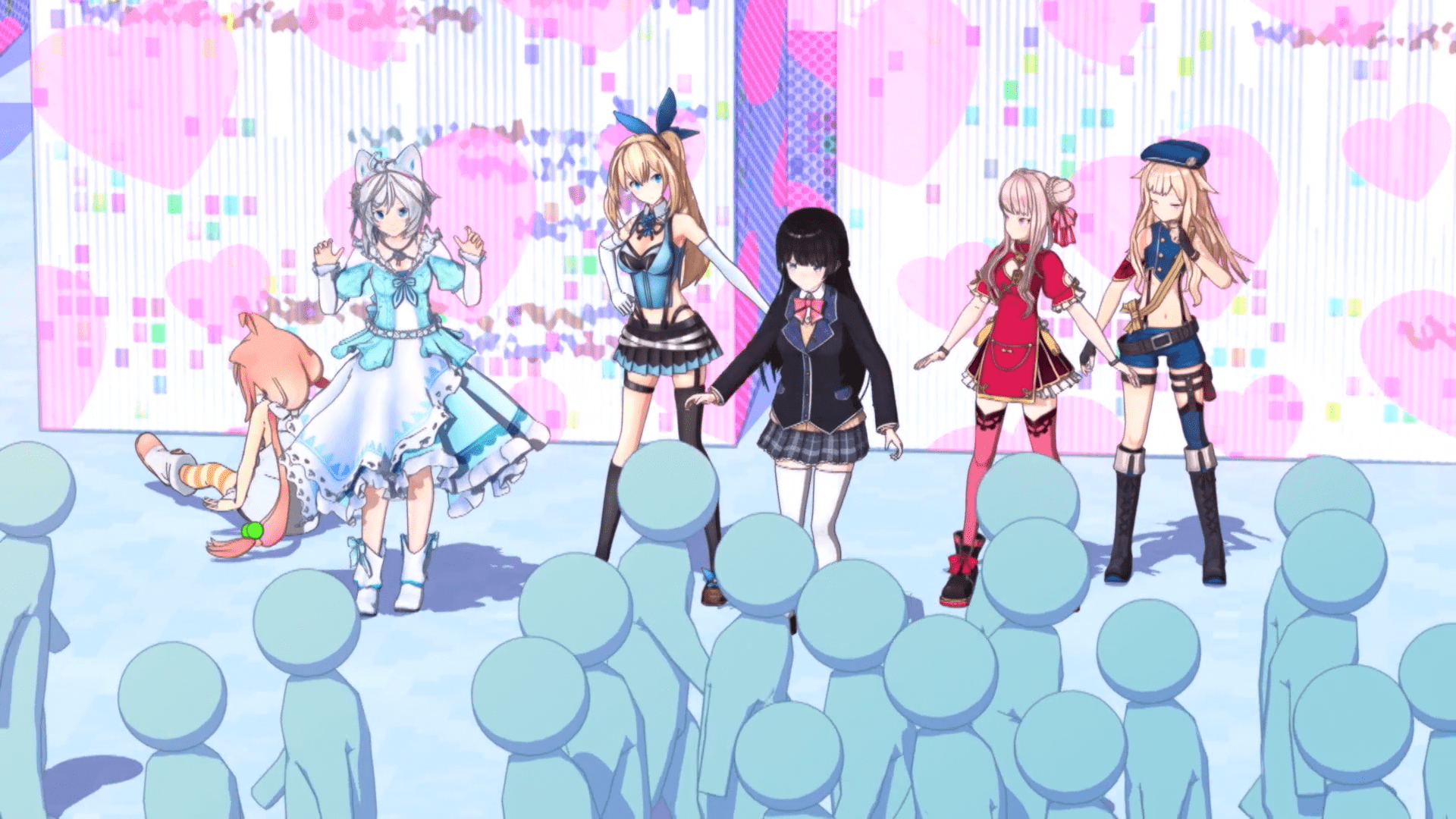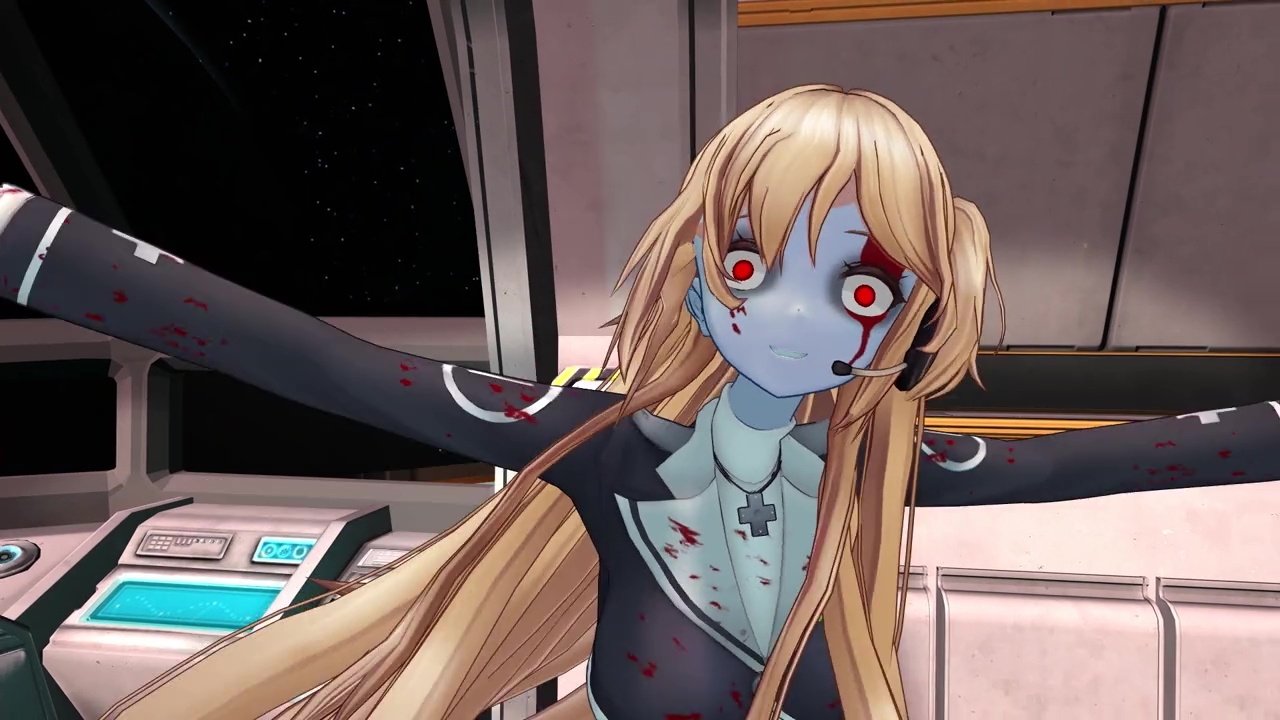 |
| From https://www.toxicer.com/storage/anime/visual_art_253n.jpg |
Viewed in Japanese with English Subtitles
Virtual-San... has to be a real curiosity for anyone who's
uncovered it on Crunchyroll. There's
probably a lot of bafflement, but for someone like me, this is literally
entering into alien territory, so much so it was.
One of the immediate interests
about streaming that, whilst Crunchyroll
and their ilk will never be able to guarantee their licenses with last or even
get a Western release on physical media, they're access to the newest titles,
streaming almost exactly the same time as the original Japanese broadcasts, for
the most parts means they get everything. That means stuff that'll be forgotten
soon after the season they started but it also means material like this that
would've only been released in the past, if any, only in the USA when there was
time almost everything got a DVD release, true died in the wool obscurities of
fascination.
This is particular example
existence is entirely based on an entirely Japanese pop cultural phenomenon,
that of the virtual YouTuber. Imagine your usual garden variety YouTuber, who
might have "Let's Plays" of videogames where you see their reactions
in the midst of the games or opinion pieces, but with the figure using a
digital avatar, voice acted and animated, usually as stereotypical anime girls;
one of the earliest was Ami Yamato,
and with Kizuna Ai the most famous. Virtual-San Looking feels like the wave
is in their favour so, probably in the best metaphor to make on this loose and
openly messy production, a group of some of the most popular got together and
decided to put on a show.
The idea is that, yes, there are
real figures behind these characters but the appearances are extensions of
themselves, something this even emphasises with a reoccurring segment on fans
of the show having their fifteen seconds as their Virtual personalities. In
complete honesty, it's a show which can be accused for many short comings but,
seeing it, I found it absolutely fascinating as a cultural artefact in the
making of this niche, whether virtual YouTubers become a thing or vanish within
the next few years. Whatever the case, even the moments of amateurism, for more
extreme then some of the series I have covered, is charming as a seven girl
group and a set of additional characters and cameos participate in sketch
comedy and non-sequiturs. And these are some highly viewed figures - Mirai
Akari (blonde, eccentric, one of the most popular of them all), Electric Girl
Siro (blue hair, quietly spoken), Nekomiya Hinata (cat eared video game
obsessive), Tanaka Hime (pink haired and over-the-top in exaggeration), Suzuki
Hina (blonde, calmer minded), and Tsukino Mito (black hair, meek, politely
spoken stereotype of a high school girl, has a joke from her YouTube page about
eating grass return here as probably one of many references I didn't get). A
lot of these hosts only came to be in 2018, so this is very much a series
trying to promote them to a wider audience as much as entertain the fan base
for " VTubers".
For the most part the series
follows a rigid template. The early episodes follows the Game Club Project, a
group in a giant spaceship who keep hatching (and botching) plans to take over
the galaxy, even considering their female senior's terrible fresh baked cookies
as a possible candidates for military supremacy. There's Virtual Grandmother, arguably
the most rewarding and consistent segment as, rather than her lame end jokes,
the real virtue here is how in her talks about growing up in the sixties, she
opens up a lot about details of Japan from the era for the Western viewer of
great interest. The main group always gets into a life threatening situation
they are doomed within, their classroom having a bad tendency to teleport somewhere
like outer space. There's Fuji Aoi Park, where another VTuber Aoi Fuji
interacts with a politely spoekn gorilla who can make bananas randomly rain
from the sky. Nekomiya Hinata, the avid gamer, thinks of game scenarios while
walking to school and solutions to them; Electric Girl Siro, meant to be an
android girl, runs a food stand (with superimposed real people in the
background) where she provides nourishment through trivia than actual grub; Tsukino
Mito also has a 3 pm class question with various guests, subjects varying from
whether one would eat grass or something else, or whether to live being able to
say some words over others. Then there's Virtual Sister, a nun who provides
moral support.
 |
| From https://www.goodjobmedia.com/wp-content/uploads/2019/03/ virtualsan07_premuxv2-81830023_001_6671.png |
The two most prominent segments are Kerin Slayer and Mirai Akari as an agony aunt. Kerin Slayer is a running story, (clearly parodying the controversial dark fantasy series Goblin Slayer (2018)) which is as much a piss take on bad animation as it is the cast, who are animated through motion capture technology throughout the series, to muck about with an elf able to summon missiles, various side cameos and projectile alcohol; its frankly silly and definitely feels the most amateurish of the whole series in terms of segments. The other, with Akari offering advice to listeners, is actually behind Virtual Grandmother as one of the most rewarding segments for me because a) she's inherently more interesting than everyone else, without prior knowledge that the figure is one of the most popular of them all in this very niche subculture, for being the character who is soft spoken but has the weirdest (and even disturbing) thoughts; that b) her solutions to the questions are always over-the-top; and c) she has a literal demonic and angelic version of herself on each shoulder that argue when her thoughts wander off which adds to the comedy.
The animation is noticeably a
step down from usual TV anime quality, but in a sense that it was clearly
considered as much part of the humour and a form of verisimilitude, feeling
from the beginning like a project put together by VTubers (including end credit
cameos and characters like the titular Virtual-San, a blue suited man with a
horse's head). The character designs of the main cast are good, if anything
helping in my theory that even with the worst in anime, female characters get
more personality just from their clothes and hairstyles, pertinent here as some
of the main leads would've gotten lost in the shuffle of seven figures if they
didn't have either their character designs and energised voice actresses. It also
doesn't deny that how VTubers work, that they are literally actors motion
captured in their movements, is a really incredible example of how advanced
technology is becoming, as for all the incidents of "clipping" (a
digital animation term where here long hair does and will indeed past through
its owner) and crude background sets, you are arguably watching a curious modern
form of rotoscoping with the added virtue that the ridiculous poses and
movements come from the actors having to actually move about in such comical
ways. Hell, whether staged or real, one scene of the agony aunt segment has the
participants moving too much for the camera to keep track of, moments
throughout the show where scenes are hastily cut down or signposted by the
production as being slightly off in the improvised nature of the show. The rest
of the show does in a way play off its animation style is ways more common for
other shows in this mould; Kerin Slayer, in particular with the
"Kerin", literally has 2D cut-out characters and stock images for
statues that have a tendency to fall into the story hiding new characters. A reoccurring
segment is also "Unity-Chan", a curry bouquet loving gamer who is
animated with Unity and is far more fluid and better animated than the rest of
the show in her segments than anyone else in the cast.
Watching Virtual-San Looking was felt entirely like an outsider, not in the
least combing an entire culture's worth of in-jokes from this, numerous anime
and otaku references likely lost to me through the twelve episodes. Also at
times it does, but in a sympathetic way, come off as very lame, its humour
corny and the show frankly silly in its hazy improvised feel, from the
off-the-cuff attempts absurdity to the audible flubs in the acting. Even its
epic, the bombastic opening with a giant robot and a mob of faceless figures,
has a sense of the redundant in it being played out with actual dialogue
halfway through the show. Sometimes to its credit it has whit, surprisingly in
what turns out to be a streak of edutainment - Virtual Grandmother is always
interesting as is Siro's trivia bar, the blue costumed robot girl offering the
surprising fact that "ero manga" is both the term for porn manga but
also "Erromango", an island in the Vanuatu archipelago that is
pronounced "Eromangatou" but happens to come off as "Eromanga
Island" in Japanese.
For myself, the larger issue on
an artistic level is more that Virtual-San
Looking doesn't challenge itself, a problem I am actually going to level to
anime comedy in general, somewhat spoilt in my youth by the fact that Excel Saga (1999), the series so
chaotic it infamously destroyed the vocals of the main English voice actress of
the titular character and lead to her being replaced midway through, ended
itself by literally throwing in a kitchen sink, a serious episode without any
humour, and a post-apocalypse finale that actually had drama. (Oh, and the
equally infamous bonus episode that went for as much offensive content as
possible and got censored before screening). In lieu to such an example, and my
general thoughts of comedy from any culture, I find comedy should try to
escalate to more imaginative or crazed levels, even more bold directions if
entirely stand up or word play based, which doesn't really happen with Virtual-San Looking. There is a sense
that, for myself, I like my anime comedy to always be creative and at least try
to end on the most inventive note possible; for all my issues with Pop Team Epic (2018) being too
indulgent in the most niche of references, and being loud and obnoxious, it had
more risk. Virtual-San instead feels
like the shy, tentative coming out party, felt in actual truth in the final
moments of the final episode where the cast address the audience hoping this is
the first stepping out for Virtual YouTubbers on TV. It feels openly modest,
without any cynicism like a Pop Team
Epic or many micro series which feel half thought-out from those I've seen.
If anything, because of this, I
have become a little obsessed with Virtual-San
Looking, feeling like an anthropologist to this world and, in spite of its
last episode being a complete anti-climax, wanting to revisit and explore this
culture until Crunchyroll's license
of the show ends. Sadly, a show like this is more than likely going to
disappear in the ether of anime's prolific amount of material, felt with
tragedy as I have a greater investment in wanting to explore this culture of
Virtual YouTubbers. This is emphasised knowing YouTube isn't as popular in Japan as Nico Nico Douga and BiliBili
as video streaming sites, making the VTubers themselves the one distinct
feature to help bolster YouTube's
reputation. Again, even they might vanish within a few years, with a limited
lifespan, as someone with an interest with outsiders and niches I have to admit
I have nothing but utter curiosity here, which brought a lot of entertainment
from Virtual-San Looking alongside
the moments which were legitimately funny and charming. That in itself is a
success on the show's part in reeling someone with no idea on the subject into
wanting to learn more.
 |
| From https://image.tmdb.org/t/p/original/ d0leR2bDpJuvceM3raZ3PPFeCnt.jpg |
No comments:
Post a Comment